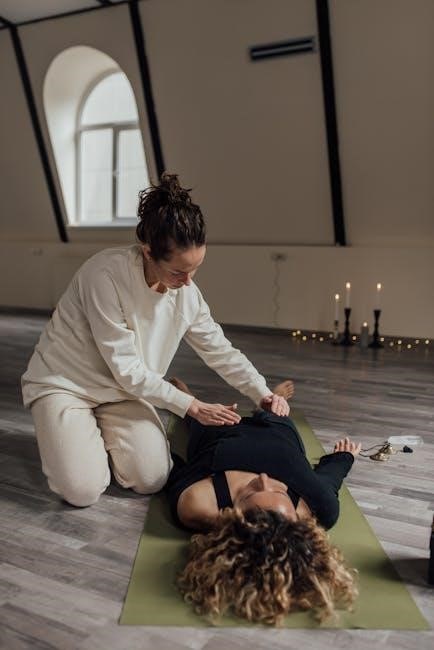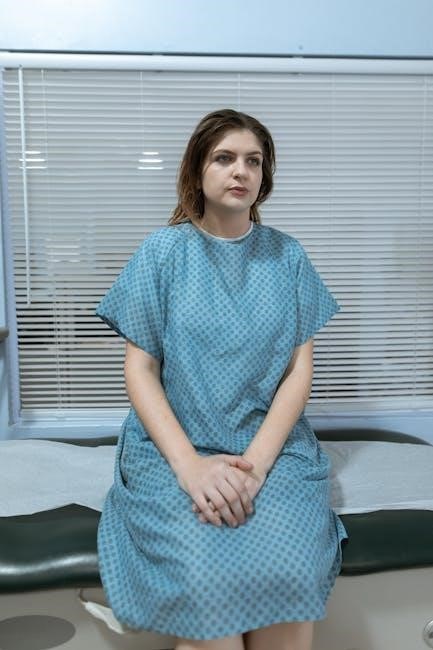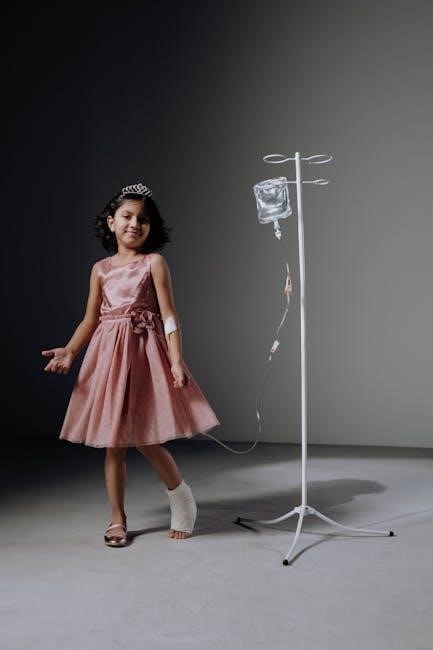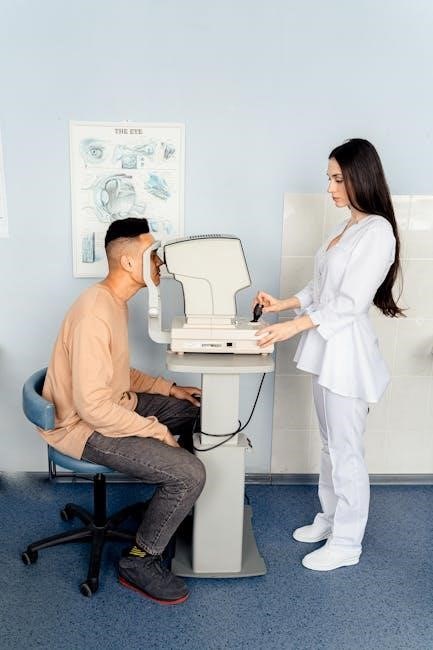Patient positioning is critical in healthcare, ensuring safety and procedural success․ Proper techniques prevent complications like respiratory distress or nerve damage, optimizing outcomes in surgeries, radiography, and emergencies․
1․1 Definition and Importance of Patient Positioning
Patient positioning refers to the precise placement of a patient’s body to ensure safety, comfort, and procedural success․ It is vital for preventing complications like nerve damage or respiratory distress․ Proper positioning optimizes surgical access, reduces risks, and enhances recovery outcomes․ Guidelines emphasize its role in minimizing injuries and promoting optimal medical access, as highlighted by the American Heart Association and other medical references․ Effective positioning is a cornerstone of quality patient care across various procedures․ It requires careful planning and adherence to established protocols to ensure the best possible results․
1․2 Historical Overview of Patient Positioning Techniques
Patient positioning has evolved significantly over time, with early practices focusing on basic anatomical alignment․ The development of modern techniques was influenced by advancements in surgery and imaging․ The Pocket Atlas of Radiographic Positioning, first published in 2009, marked a milestone in standardizing these methods․ Recent guidelines, such as those from the American Heart Association, highlight the importance of prone positioning in critical care․ Historical advancements have refined patient positioning, ensuring better safety, comfort, and procedural outcomes, as detailed in resources like the AliMed Patient Positioning Guide․

Types of Patient Positions
Patient positions include supine, prone, lithotomy, Sims, dorsal recumbent, lateral, and knee-chest․ Each position serves specific medical purposes, ensuring optimal access and patient comfort during procedures․
2․1 Supine Position
The supine position involves placing the patient on their back, with arms at their sides or across the chest․ It is commonly used for general exams, surgeries, and radiographic procedures due to its versatility․ Pillows or supports may be placed under the knees to reduce lower back strain․ This position allows easy access to the chest and abdominal areas, making it ideal for procedures requiring central access․ Proper alignment is crucial to prevent nerve compression and ensure patient comfort․ It is widely regarded as the most straightforward and accessible position for many medical interventions․

2․2 Prone Position
The prone position involves placing the patient on their stomach, with arms extended or tucked under the body․ It is often used in surgeries requiring access to the spine, kidneys, or posterior regions․ Proper padding and supports are essential to avoid pressure sores and nerve damage․ This position can improve respiratory mechanics in patients with acute respiratory distress syndrome (ARDS)․ Regular repositioning and monitoring are crucial to ensure comfort and safety, as prolonged prone positioning can lead to complications like skin breakdown or circulatory issues․
2․3 Lithotomy Position
The lithotomy position places the patient on their back with legs elevated and supported in stirrups․ Commonly used in gynecological, urological, and colorectal procedures, it provides optimal access to the pelvic area․ Proper positioning reduces the risk of complications such as nerve damage or pressure sores․ Supports and padding are essential to maintain patient comfort and safety․ Regular monitoring ensures the patient remains stable during procedures, minimizing discomfort and potential circulatory issues․
2․4 Sims Position
The Sims position is commonly used for gynecological exams, treatments, and minor surgical procedures․ The patient lies on their side with one leg flexed and the other extended, providing easy access to the pelvic area․ This position is also utilized for rectal exams and enemas․ Proper use of pillows and supports ensures patient comfort and prevents strain, making it a versatile and effective positioning technique in various medical settings․
2․5 Dorsal Recumbent Position
The dorsal recumbent position involves the patient lying on their back with legs elevated and supported by stirrups or a lithotomy device․ This position is ideal for gynecological, abdominal, and pelvic procedures, providing easy access to the surgical site․ It is widely used in surgeries such as hysterectomies and cesarean sections․ Proper padding and supports are essential to prevent nerve damage and ensure patient comfort during prolonged procedures․
2․6 Lateral Position
The lateral position places the patient on their side, often for procedures requiring access to the chest, abdomen, or spine․ Padding supports the legs, arms, and head to maintain alignment and prevent injury․ This position is commonly used in thoracic surgeries, orthopedic procedures, and pain management interventions․ Proper positioning ensures optimal surgical access while minimizing complications such as nerve damage or respiratory discomfort․ It is crucial to secure the patient to prevent movement during the procedure․
2․7 Knee-Chest Position
The knee-chest position involves the patient kneeling and lying forward, with the chest nearly touching the table․ Pillows support the chest and knees for comfort․ This position is often used in spinal surgeries, gastrointestinal procedures, and certain gynecological exams․ It allows excellent access to the lower back and pelvic area while minimizing respiratory compromise․ Proper alignment and padding are essential to prevent nerve injury and discomfort․ The patient’s head is typically supported with a neutral spine alignment to ensure safety and stability during the procedure․

Patient Positioning in Specific Medical Procedures
Patient positioning is tailored to specific medical procedures, ensuring safety, optimal access, and procedural success․ Proper techniques are essential in surgeries, radiography, and emergencies to minimize complications and enhance outcomes․
3․1 Surgical Patient Positioning
Surgical patient positioning is critical for optimal anatomical access, minimizing complications, and ensuring patient safety․ Common positions include supine, prone, and lithotomy, each tailored to the procedure․ Proper alignment and support are essential to prevent nerve damage or respiratory issues․ Guidelines emphasize the role of the surgical team in confirming the patient’s identity and medical history before positioning․ Accessories like pillows, stirrups, and traction devices are used to maintain stability․ Correct positioning ensures optimal surgical access while prioritizing patient comfort and reducing the risk of postoperative injuries․
3․2 Radiographic Patient Positioning

Accurate patient positioning is essential in radiography to obtain high-quality images and diagnose conditions effectively․ Common positions include supine, prone, and Sims, each optimizing anatomical alignment for specific exams․ The Pocket Atlas of Radiographic Positioning serves as a key resource, guiding technicians to ensure proper alignment and patient safety․ Laser systems enhance precision, streamlining workflows in imaging suites․ Proper positioning minimizes radiation exposure and ensures clear, diagnostic-quality images, aiding in accurate medical assessments and treatment planning․
3․3 Emergency Patient Positioning
Emergency patient positioning requires quick, precise techniques to address critical conditions․ Prone positioning is often used for respiratory distress, improving oxygenation and reducing complications․ Trauma patients benefit from lateral or supine positions to stabilize injuries․ Guidelines emphasize minimizing movement and ensuring proper alignment to prevent further harm․ Resources like the AliMed guide provide protocols for emergency situations, while improper positioning can lead to long-term complications․ Accurate positioning is vital for immediate care and patient recovery in high-stakes scenarios․
Patient Positioning Guidelines and Recommendations
Patient positioning guidelines aim to ensure safety and optimal outcomes․ The AliMed guide provides detailed protocols for preventing injuries and improving surgical access, emphasizing proper techniques and adherence to standards․
4․1 Guidelines for Preventing Positioning Injuries
Guidelines for preventing positioning injuries emphasize proper techniques and equipment use․ The AliMed Patient Positioning Guide recommends using supports and pillows to maintain alignment and reduce strain․ Regular staff training on positioning protocols is crucial to minimize risks․ Additionally, the Pocket Atlas of Radiographic Positioning highlights the importance of padding bony prominences and avoiding prolonged pressure on sensitive areas․ These strategies help ensure patient safety and comfort during medical procedures, minimizing the likelihood of injury․
4․2 Recommendations for Optimal Surgical Access
Optimal surgical access requires precise patient positioning to enhance visibility and minimize complications․ The Pocket Atlas of Radiographic Positioning and AliMed guides emphasize using tilting or elevating tables․ Positioning devices like stirrups or shoulder braces help maintain stability․ Regular training ensures staff can adapt positions to individual needs, balancing access with patient safety․ Proper alignment prevents nerve compression and ensures unobstructed surgical views, critical for successful outcomes․
4․3 American Heart Association (AHA) Guidelines for Prone Positioning in Stroke Patients
The American Heart Association recommends prone positioning for stroke patients to improve respiratory function and reduce complications․ This technique, supported by guidelines, enhances oxygenation and prevents aspiration․ Proper training ensures safe implementation, minimizing risks of nerve injury or skin breakdown․ Regular monitoring of neurological status is crucial․ Prone positioning is especially beneficial for patients with acute respiratory distress, promoting better ventilation-perfusion matching․ Adherence to AHA guidelines ensures optimal outcomes, balancing benefits and risks effectively․
Patient Positioning Equipment and Accessories
Medical beds, positioning devices, pillows, and laser systems are essential for precise patient alignment, ensuring safety and procedural success in various healthcare settings and treatments․
5․1 Medical Beds and Positioning Devices

Medical beds and positioning devices are essential for patient care, offering adjustable features to accommodate various positions like orthopneic, lithotomy, and dorsal recumbent․ These devices enhance safety, comfort, and procedural efficiency, ensuring optimal alignment for surgeries, radiography, or recovery․ Advanced models include countertraction posts and adjustable leg supports, while accessories like pillows and straps help prevent slipping and strain․ The AliMed Patient Positioning Guide emphasizes their role in minimizing complications and improving outcomes across diverse medical procedures․ Proper use of these tools is vital for patient well-being and procedural success․
5․2 Positioning Pillows and Supports
Positioning pillows and supports are crucial for maintaining patient alignment and comfort during medical procedures․ Lumbar and small pillows under the knees reduce strain and prevent slipping․ These tools are versatile, used in surgeries, radiography, and emergencies․ Proper placement minimizes complications, ensuring patient safety and procedural success․ The AliMed Patient Positioning Guide highlights their importance in optimizing patient stability and comfort, aiding in precise positioning for diverse medical scenarios while preventing long-term discomfort or injury, thus enhancing overall care quality and efficiency in healthcare settings․
5․3 Laser Systems for Accurate Positioning
Laser systems play a pivotal role in ensuring accurate patient positioning, particularly in imaging and treatment settings․ LAPs laser systems are designed for precision, enabling repeatable and accurate alignment․ These systems streamline workflows, enhancing efficiency in medical procedures․ By providing clear visual guides, they help in achieving optimal positioning, reducing errors, and improving patient safety․ Their application is vital in radiography and surgical settings, ensuring precise alignment for diagnostic and therapeutic interventions, thereby contributing to better procedural outcomes and patient care quality․

Patient Positioning in Emergency Situations
In emergencies, proper positioning is crucial for patient stability and outcomes․ Techniques like prone positioning aid respiratory distress, while trauma positioning focuses on injury assessment and stabilization․
6․1 Prone Positioning for Respiratory Distress
Prone positioning is a critical technique for patients with severe respiratory distress, improving oxygenation and reducing mortality․ It enhances lung recruitment and promotes even ventilation․ Widely adopted in emergencies and ICUs, prone positioning is particularly effective for patients with acute respiratory failure․ Guidelines recommend its use for non-intubated patients, as it alleviates breathing difficulties and supports recovery․ Proper implementation ensures safety and avoids complications, making it a vital strategy in respiratory care․
6․2 Positioning for Trauma Patients
Proper positioning is vital for trauma patients to prevent further injury and promote healing․ Techniques like logrolling maintain spinal alignment, reducing risk of neurological damage․ The use of supportive devices ensures immobilization and comfort․ Guidelines emphasize assessing injuries to tailor positioning, minimizing pain and complications․ This approach is crucial in emergencies, ensuring patient stability and optimal recovery outcomes․
Patient Positioning Resources and References
Essential resources include the AliMed Patient Positioning Guide and the Pocket Atlas of Radiographic Positioning, offering practical, evidence-based guidance for healthcare professionals to ensure optimal patient care․
7․1 Patient Positioning Guide by AliMed
The AliMed Patient Positioning Guide is a comprehensive resource designed to assist healthcare professionals in optimizing patient positioning․ It provides detailed strategies for various procedures, ensuring safety and comfort․ The guide covers common positions like supine, prone, and lithotomy, offering practical tips for minimizing risks․ Available in PDF format, it serves as a ready-reference guide, helping to standardize positioning practices across medical settings․ Its clear organization and evidence-based recommendations make it an indispensable tool for improving patient outcomes and streamlining workflows․
7․2 Pocket Atlas of Radiographic Positioning
The Pocket Atlas of Radiographic Positioning by Torsten Bert and Reif Moeller is a concise yet comprehensive guide for radiographic procedures․ Available as an E-Book and PDF, it offers clear, organized instructions for positioning patients in various radiographic examinations․ The atlas includes detailed illustrations and practical examples, making it a valuable resource for both education and clinical practice․ Its focus on accuracy and reproducibility ensures high-quality imaging, aiding professionals in achieving optimal results while maintaining patient safety and comfort during procedures․
